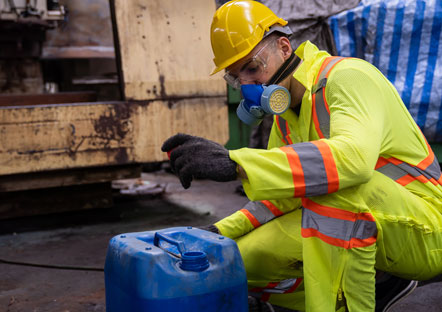Advancing environmental due diligence in real estate and brownfield development.
Cameron-Cole Phase I Environmental Site Assessments (ESA)





An on-site inspection, under the supervision of an environmental professional, will document relevant surface features that may suggest RECs are present.
The historical usage and history of the subject property is examined for potential risks. This includes aerial, topographical, fire insurance maps, city directories and property owner interviews where available.
The ASTM Standard is the only US EPA-approved guidance that qualifies as an AAI to ensure limited liabilities protection for real estate.


A purpose-driven provider of Global Business Services solutions that advances sustainable business and operational practices by transforming risk into positive impact and value.






Do you have a solution that would make a good addition to the ADEC Enterprise Marketplace? Fill out the form below and we will be in touch within the next 1-2 business days.
Do you have a solution that would make a good addition to the ADEC Enterprise Marketplace? Fill out the form below and we will be in touch within the next 1-2 business days.

佳福(福建)染整有限公司成立于2012 年,隶属于三福(中国)集团旗下,现有 员工1000余人。引进高效、节能、环保的 染整设备,被评为泉州市“智能制造数字 化示范车间”;通过ISO9001\ISO14001\OHSAS18001等质量、环境、职业健康 安全等管理体系;通过了国际OEKOTEX ®STANDARD 100、BLUESIGN®认证和 GRS认证,检测中心获国家合格评定认可 实验室,使产品在研发、采购、生产、检测 的过程中符合绿色环保要求。
佳福注重产品研发和流行趋势开发,多次 荣获国家级奖项,如“ 中国时尚面料入围 企业”、“优质化纤面料金奖”等国家级奖 项。
佳福注重环境保护与绿色可持续发展,先 后被评为生态治理先进单位、福建省级绿 色工厂、全国纺织行业绿色发展节水型企 业;

随着环境问题成为人们关注的焦点,品牌、监管机构和消费者都要求供应商提高透明度,承担更大的责任。但这对服装和纺织行业的供应商意味着什么?
数据表明:
70%的品牌更喜欢拥有透明的可持续发展数据的供应商。品牌正在优先考虑那些能够提供可验证数据的供应商。如果没有透明度,供应商就有可能把业务输给已经准备好的竞争对手。
时尚供应链占全球碳排放量的10%。服装业是造成气候变化的最大因素之一。减少碳排放不再仅仅是合规性的问题,而是关于在一个可持续性是品牌和消费者的关键决策因素的市场中保持相关性。。
纺织生产占全球工业水污染的20%。纺织制造中的化学密集型工艺造成了严重的水污染。品牌越来越多地执行更严格的环境要求,这使得供应商必须改善废水管理和化学品合规性。
CleanChain如何赋能供应商?
供应商需要合适的工具来应对这些挑战并实现可持续发展目标。CleanChain简化了环境合规和可持续发展报告,帮助供应商
✅自动化合规性追踪,并确保符合ZDHC MRSL和其他法规。
✅通过实时数据洞察和性能监控减少碳和水足迹。
✅改善化学品管理,确保更安全、更可持续的生产过程。
✅通过提供经过验证的、透明的可持续发展数据,与品牌建立信任。
可持续供应链的未来
可持续性不仅仅是满足法规要求——它还关乎提高竞争优势,加强品牌关系,以及企业的未来发展。随着对可持续发展的期望不断提高,主动适应的供应商将最有利于长期成功。
cleanchain.cn@adec-innovations.com

东丽酒伊织染 (南通) 有限公司 (公司简称 TSD), 成立于1994年, 是东丽集团 (Toray) 在中国投资规模最大的制造型公司, 是一家以化学合成纤维为主的坯布织造、功能性面料加工·染色、成衣制造销售及水处理 为核心事业的公司。公司拥有从新技术研 发、织造/染色/后整理/检测及成衣制 造的一条龙生产流程。作为东丽海外的标 杆工厂, TSD拥有一流的安全、环境和职业 卫生、能源管理体系, 践行着TSD对于社会 责任感的承诺。公司秉承“通过创造新的 价值为社会做贡献”的企业理念, 以不懈的 创新精神和科技实力为客户不断开发品质 上乘、性能卓越的面料, 谋求与每一位顾客 的共同发展。
客户面临的挑战
在采用CleanChain这款在线化学品管理系统之前, 我们在执行ZDHC的过程中, 由于化学品使用类别多且量大, 很难实现实时追踪现有化学品的MRSL合规性。同时, 针对没有合规性的化学品以及证书到期的产品, 我们需要人工核实和整理相关列表, 并一一和化学品制剂商进行沟通。整个过程需要花费大量的时间,极大地影响我们的工作效率。另外, 如何提高MRLS的整体符合性,也是我们的一大挑战。最后, 在采用系统前, 我们不明确我司客户对于我们进入CleanChain平台持何种态度及其认可程度如何。
CleanChain解决方案
我司化学品管理工作者每月在系统里按时上传化学品清单,并下载InCheck报告。为了避免用户错过上传的时间截点, CleanChain还会有自动化的邮件提醒用户及时上传化学品数据。除了定期上传化学品数据外, 我们日常工作中,也会利用系统的Dashboard来查看到期的产品以及没有合规性的产品列表。根据这份列表, 我们有针对性地和化学品供应商开展高效的沟通, 鼓励并帮助他们对未合规的产品进行检测并上传至ZDHC Gateway网关。同时, 在数据的分享上, 通过CleanChain的connect功能, 与客户取得关联, 系统可自动帮助用户将CIL数据和InCheck报告分享给我们的合作品牌。CleanChain在数据的管理上, 帮助我们节省了手动分享报告和清单的时间, 大大地提高了工作效率 。
CleanChain带给我们的价值
采用CleanChain系统,在很大程度上帮助我司规避了化学品的风险物质, 也大大提高了我司化学品管理方向的工作效率。同时, CleanChain系统的采用提升了客户对于我司的认可度及信任度, 尤其是对于了解或者已经使用CleanChain平台的客户而言。最后, CleanChain促进了我司可持续发展进程。
联系我们 cleanchain.cn@adec-innovations.com
Land Conservation & Sustainable Agriculture Training
Our training programs focus on empowering stakeholders to adopt sustainable land management, agriculture, and conservation practices.
Marine & Ocean Management Training
ADEC offers training for marine conservation, sustainable fisheries, and ocean resource management, aimed at preserving marine biodiversity and ensuring sustainable use of marine ecosystems.
Urban Sustainability & Smart City Training
Our urban-focused training programs help cities and urban projects adopt sustainability measures, enhance resilience, and implement green infrastructure.
Circular Economy & Resource Efficiency Training
ADEC provides training and education to help organizations transition to circular economy models, focusing on resource efficiency and sustainable supply chain practices.
ADEC offers expert project implementation and management support for organizations and companies creating measurable environmental and social impact. We provide hands-on management and oversight to ensure that sustainability-focused initiatives across land, ocean, urban environments, and the circular economy are successfully executed. Our services ensure that projects deliver on their impact goals, remain on budget, and comply with regulatory and sustainability standards.
Land Conservation & Sustainable Agriculture
ADEC provides management services for projects focused on land restoration, agriculture, and biodiversity conservation, ensuring sustainable practices are implemented effectively.
Marine & Coastal Restoration
For marine and coastal projects, ADEC offers specialized management services to protect ocean biodiversity and promote sustainable use of marine resources.
Urban Sustainability & Smart Cities
ADEC provides management services for urban sustainability projects, ensuring the successful execution of climate resilience initiatives, smart city technologies, and infrastructure improvements.
Circular Economy & Waste Management
ADEC offers project management for circular economy initiatives, focusing on recycling, waste management, and sustainable supply chains.
Land Conservation & Sustainable Agriculture
Our programme management services for land- based projects focus on restoring ecosystems, enhancing carbon sequestration, and promoting sustainable agricultural practices.
Marine Conservation & Blue Carbon
For marine and coastal projects, ADEC provides programme management expertise to help protect ocean ecosystems and increase carbon capture in marine environments.
Urban Sustainability & Green Infrastructure
We support urban sustainability initiatives by managing projects that promote climate resilience, reduce environmental footprints, and improve resource efficiency in cities.
Circular Economy Projects
ADEC provides expertise in managing projects that support the transition to a circular economy, from infrastructure development to innovative technologies and sustainable supply chains.
ADEC offers cutting-edge Data & Technology Solutions designed to support impact investors in monitoring and managing sustainability projects. Our solutions leverage advanced technologies, such as satellite monitoring, IoT, blockchain, and data analytics, to provide real-time insights into environmental and social impact. These tools enable investors to make informed decisions, track project progress, and ensure that investments deliver measurable, positive outcomes across land, ocean, urban, and circular economy projects.
Land Conservation & Sustainable Agriculture Technology
We provide advanced technological tools to monitor and manage land conservation and sustainable agricultural projects, ensuring real-time tracking of environmental impacts.
Marine & Ocean Monitoring Technology
For ocean and marine conservation projects, ADEC offers cutting-edge technologies to monitor marine ecosystems and ensure the sustainable management of ocean resources.
Urban Sustainability & Smart City Technology
ADEC provides advanced data and technology solutions to help cities and urban projects enhance sustainability, improve efficiency, and build resilience against climate challenges.
Circular Economy & Supply Chain Technology
ADEC offers innovative technology solutions to drive transparency, traceability, and sustainability within circular economy projects and global supply chains.
ADEC provides policy development and advisory services to guide companies, organizations, and projects driving positive environmental and social impact. We support impact investors and their investees in shaping, implementing, and aligning policies that promote sustainability across land management, ocean conservation, urban resilience, and the circular economy. Our expertise ensures that projects not only meet regulatory requirements but also lead the way in sustainable innovation and practice.
Land Conservation & Sustainable Use Policies
We offer expert advisory to support sustainable land management practices that enhance environmental resilience and biodiversity while ensuring long-term sustainability.
Ocean & Marine Conservation Policies
For organizations committed to protecting marine environments, ADEC provides guidance on policy development that safeguards ocean ecosystems and supports sustainable marine economies.
Urban Sustainability & Smart City Policies
Our advisory services in urban sustainability help cities and urban projects design and implement policies that promote energy efficiency, climate resilience, and sustainable growth.
Circular Economy & Waste Management Policies
ADEC supports organizations in developing policies that promote circularity, reduce waste, and encourage sustainable procurement practices.
Land Conservation & Sustainable Use
We support land conservation projects by helping investee companies and organizations secure the funding they need to achieve their goals in sustainable land management.
Ocean Conservation & Blue Economy
For organizations focused on marine conservation and sustainable ocean use, ADEC offers specialized support in accessing critical funding sources.
Urban Sustainability & Green Infrastructure
Our services empower projects that aim to transform cities into sustainable, climate-resilient urban areas through access to specialized funding and investment.
Circular Economy & Waste Management
For organizations focused on reducing waste and promoting circular economy practices, we provide support to access funding and financing mechanisms.
ADEC offers a suite of Impact Measurement & Reporting solutions designed to help impact investors evaluate the environmental and social outcomes of their investments. Our services are tailored to assess projects across land, ocean, urban sustainability, and the circular economy, providing transparent and reliable data that ensures measurable impact. We enable investors to track key performance indicators (KPIs), monitor progress, and report on the tangible impact of the projects they fund.
Land Conservation & Reforestation Metrics
We provide detailed measurement and reporting on land-based projects, focusing on carbon capture, water use, and ecosystem restoration.
Marine Conservation & Blue Carbon Monitoring
For ocean and marine projects, we specialize in tracking the health of marine ecosystems and quantifying carbon capture in coastal environments.
Urban Sustainability & Climate Resilience Reporting
ADEC offers impact measurement services for urban sustainability projects, focusing on energy efficiency, emissions reductions, and climate resilience.
Circular Economy & Waste Management Metrics
For circular economy projects, we provide specialized measurement and reporting on waste reduction, resource efficiency, and supply chain sustainability.